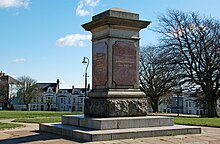Siege of Plymouth
When the war began in August 1642, Parliamentary forces secured most of southern and western England, including the ports of Plymouth and Exeter, and the bulk of the Royal Navy.An exception was Plymouth, where the garrison was commanded by Colonel William Ruthven, and a contingent of experienced Scots mercenaries; their ship stopped to pick up supplies returning from Ireland in early October, and the Parliamentary town council hired them to defend the city.Although Royalist cavalry imposed a land blockade on 15 September, siege operations did not begin until mid-October, allowing London to send 500 reinforcements, under Colonel James Wardlow, an experienced professional who became garrison commander.Cannon placed in Mount Stamford could not stop ships entering Plymouth Sound, and resupplying the town, while abandoning these fortifications reduced the strain on the garrison.In January 1644, Wardlaw was replaced as commander by Colonel Gould; the blockade was lifted for a short period in July, when the Earl of Essex brought his army into the South West.This allowed the garrison to refuse terms and with the Royalist army urgently needed elsewhere, Charles left only a minor force under Sir Richard Grenville to continue the blockade.
First English Civil WarPlymouthParliamentarianRoyalistsParliamentariansPrince MauriceSir Richard GrenvilleSir John Bampfylde1st HullMarshall's ElmPortsmouthBabylon HillPowick BridgeKings NortonEdgehillAylesburyBrentfordTurnham GreenFarnham CastlePiercebridgeTadcaster1st ExeterMuster Green1st BradfordChichesterBraddock Down1st MiddlewichHopton HeathSeacroft MoorCamp HillLichfieldRipple FieldReadingSourton Down1st Wardour CastleStrattonWakefield1st WorcesterChalgrove FieldAdwalton Moor2nd BradfordBurton BridgeLansdowneRoundway Down1st BristolGainsboroughGloucester2nd HullAldbourne Chase1st NewburyWincebyOlney Bridge1st Basing HouseHeptonstall2nd Wardour CastleSouth HartingBramber BridgeArundel2nd MiddlewichNantwichNewcastle1st Lathom HouseNewarkBoldon HillStourbridge HeathCheritonLyme RegisLincoln1st OxfordBolton2nd Basing HouseTipton GreenOswestryCropredy BridgeMarston MoorGunnislake New BridgeOrmskirkLostwithielTippermuir1st AberdeenMontgomery Castle1st Chester1st TauntonCarlisle2nd NewburyInverlochyHigh Ercall HallWeymouthScarborough Castle2nd TauntonAuldearn3rd Taunton2nd OxfordNasebyAlford2nd Lathom HouseLangportHerefordKilsyth2nd BristolPhiliphaugh2nd ChesterRowton HeathSherburn in Elmet3rd Basing HouseAnnan MoorDenbigh GreenShelford HouseBovey HeathTorringtonStow-on-the-Wold3rd Oxford2nd AberdeenLagganmore2nd WorcesterRoyalistParliamentaryExeterRoyal NavyPlymstockSir Ralph HoptonCornwallmilitiaWaller'sPrince RupertBristol